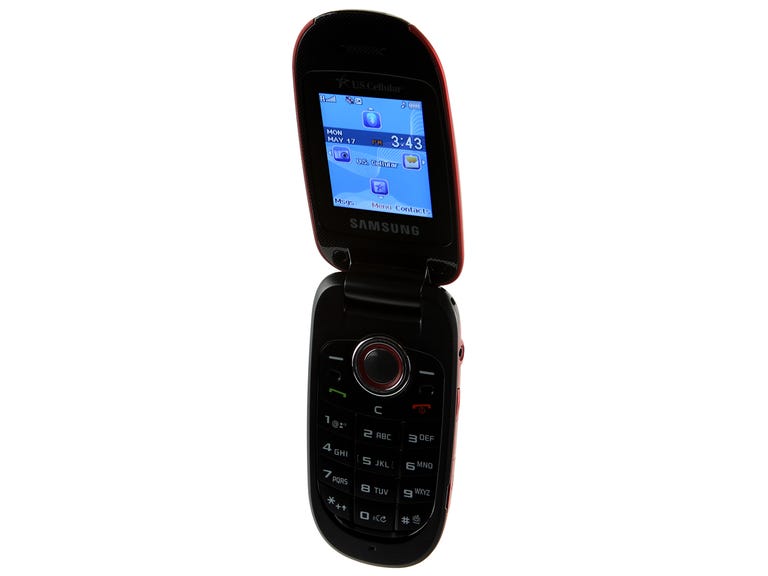 Why You Can Trust CNET
Why You Can Trust CNET Samsung SCH-R330 Stride - red (U.S. Cellular) review: Samsung SCH-R330 Stride - red (U.S. Cellular)
Samsung SCH-R330 Stride - red (U.S. Cellular)
The Good
The Bad
The Bottom Line
Basic flip phones aren't going away any time soon, and the Samsung Stride for U.S. Cellular is one example of exactly that. The Stride is an entry-level camera phone without any frills--just a simple 1.3-megapixel camera, Bluetooth, and a few essentials. That also means, however, that the Stride is cheap. It's only $29.95 with a contract.
Design
Though it is a basic phone, the Samsung Stride is not without style. Measuring 3.66 inches long by 1.89 inch wide by 0.7 inch thick, the Stride is curved and compact with rounded corners. It's wrapped in a smooth red chassis, while a black dotted pattern surface covers the front. At 3.10 ounces, the Stride is lightweight enough to fit in a pocket.

On the front of the phone is a small 1.0-inch external display. It only has a 96x96-pixel resolution and 65,000 colors, but it works fine for displaying the normal date, time, signal strength, and battery life information. It works as a self-portrait viewfinder and will also display photo caller ID. You can adjust the wallpaper, clock format, and contrast of the display.
The camera lens sits above the external display, while the volume rocker is on the left spine. On the right are the 2.5mm headset jack, the dedicated camera key, and the charger jack.
Flip open the phone and you'll find a simple 1.9-inch main display with 262,000 colors. Images looked bright and colorful, and text was crisp as well. You can adjust the menu style, the clock format, the dialing font size, the greeting text from the home screen, and the backlight time.
Underneath the display is the navigation array, which is dominated by a round chrome toggle in the middle. The toggle also corresponds to four user-defined shortcuts, plus there's a center confirmation key. The toggle is surrounded by two soft keys, the Send key, the Clear key, and the End/Power key. The keys may seem a little flush to the surface, but there are slight bumps beneath the keys, so we could still navigate by feel.
Right under the navigation array is the number keypad. The keys are spaced apart well and are distinctly separate from each other. We were able to text and dial with speed, thanks to the nice springy feel of the rubberized keys.
Features
The Samsung Stride has a 500-entry phonebook with room in each entry for five numbers, an e-mail address, and a picture for caller ID. You can also add callers to groups and assign each contact with one of 17 polyphonic ring tones or alert sounds. Other essentials include a speakerphone, a vibrate mode, text and multimedia messaging, a memo pad, a calendar, an alarm clock, a world clock, a calculator, a stop watch, a unit converter, and a tip calculator. More advanced features include voice command support, a wireless Web browser, and Bluetooth. Aside from that, there aren't a whole lot of features offered--you won't get e-mail or a music player, for example.

You do get a 1.3-megapixel camera, though. The camera is quite basic--settings include four resolutions, three picture quality settings, five white balance presets, five color effects, four shot modes, and a self-timer. Picture quality was OK for such a low-megapixel camera, but we did wish it was a little sharper and that the images didn't look so purple.

Of course, you can also personalize the phone with a variety of wallpaper and alert tones. You can use your own, or you can download them from the U.S. Cellular store.
Performance
We tested the Samsung Stride in San Francisco using one of U.S. Cellular's roaming partners. Call quality was very good on the whole. We heard our callers very clearly without a lot of static, though we did hear a bit of background noise at times.
On their end, callers said we sounded good as well. They reported a little bit of environmental noise and a bit of a tinny effect, which hinted to them that we were on a cell phone. Still, we carried on a conversation just fine. On speakerphone, they said we sounded rather muffled. On our end, we heard them loud and clear through the speakers, but they definitely sounded more hollow and tinny.
The Samsung Stride has a rated battery life of 4.5 hours talk time and 10.4 days standby time. It has a tested talk time of 3 hours and 59 minutes. According to the FCC, it has a digital SAR of 0.72 watt per kilogram.


